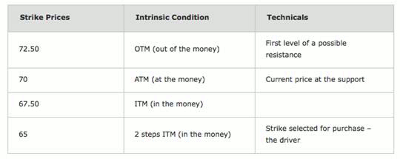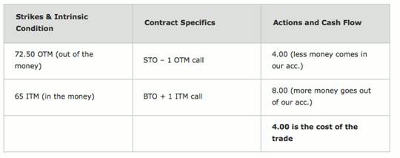A recent trading example shows the construction and execution of a vertical debit spread option trade, which is designed to minimize the often costly impact of time decay.
Let us start with the concept of plain vanilla options; there are many different and exotic names used to define different options strategies, but what we mean by “plain vanilla” is simply a single-legged call or put. For simplicity's sake, we will focus just on a long call.
In my Stamford, CT options class, we went through the methodological steps of trading options. The first step involved finding a fundamentally strong underlying stock for which we have some certainty that it will not get delisted like, for instance, Fannie Mae and Freddie Mac were.
The second step involved technical analysis, which the class loved. This step led us to the conclusion that the particular underlying that the class selected was sitting at its support after it had tested it several times and failed to break to the downside.
The third step involved looking at the implied volatility (IV) of the underlying asset. After checking out the current IV reading against its 52-week historical volatility high and low, the following conclusion was made: IV was low, which meant that we should be a buyer of options.
The fact was that the IV was not necessarily at its lowest reading, but just at its lowest range, which means that we could do either a long vertical debit spread or simply a single-legged long call.
In order to explain how the more complicated vertical debit spread works, I needed to break the long call into segments. Figure 1 displays that decomposition. At the time, the underlying was trading at $70 per share.
The selected contract at the time had over 60 days of life expectancy. The logic for that choice was that the time decay is not as rapid as when the option is bought only a week away from the expiry. The strike selection was 65, which means that the option contract at the time of purchase had five dollars of intrinsic value, yet the market makers had marked up the premium to $8.00 per contract.
Those three points of “fluff,” or extrinsic value, would be gone at expiration if the stock stayed at $70. Well, in that case, we, as the traders of options, are limited in terms of what we have because we have a decaying asset that works against us by the mere passage of time.
If the underlying is sitting at support and it does not bounce up, then with every single passing day, our option premium will lose its value. One thing is certain when trading options: The time value will eventually go out of them. To overcome this disadvantage, we need to turn the tables around. Hence, the long debit call spread.
NEXT: Part Two: The Long Vertical Debit Call Spread (Bull Put)
|pagebreak|Part Two: A Long Vertical Debit Call Spread (Bull Put)
Let us now focus on defining what a vertical spread actually is. It is a trade in which the simultaneous buying and selling of the same class of option is performed on the same underlying. It can be done with either all puts or all calls, but no mixing of the two.
In our case, the stock was sitting at support, which was coincidentally a round number. Our technical analysis told us that there was resistance at $72.50, so the idea was to sell the $72.50 strike price because most likely, the price will not puncture through that $72.50 zone. Different option strike price levels are listed in the figure below.
Starting from the bottom up, the 65 strike price was selected because it is deep in the money (ITM) and has an intrinsic value of five points, since currently the stock is trading at $70. The $67.50 strike is also ITM, but not as deep as the $65.
The $70 is both the support, and also, intrinsically speaking, at the money (ATM). The $72.50 is out of the money (OTM) and it is the level of resistance that we want to use.
Hence, the vertical spread can be built in the following way. The first step involves buying the 65 call, and the second step is selling the 72.50 call. In Figure 3, for buying, we use the term “plus one BTO” (buy to open), and for selling, “minus one STO” (sell to open) call.
Let me explain the premium first. The OTM premium will be the smallest, while the ITM will be the highest. The ATM will be in between those extremes.
For instance, our long 65 call costs $8, while the short 72.50 brings in $4 premium. When the money ($4.00) that we take in by selling the OTM option is subtracted from the money that is paid out ($8.00) for the ITM call, that leaves a $4.00 debit. By selling the OTM option, the trader has received a discount in the amount of the premium sold.
Another way to examine what the spread is composed of is listed in Figure 4.
NEXT: Part Three: Comparing the Two Breakeven Points
|pagebreak|Part Three: Comparing the Two Breakeven Points
Finally, let us now compare the breakeven point (BEP) of these two trades by assuming that at expiry, the underlying has not done anything and is still sitting at $70.
The single-legged call's BEP is the $65 strike price plus the premium paid ($8), equaling $73. At expiry, the call would lose three dollars in value, which is exactly those three points of fluff.
In the case of the spread trade, the BEP is the sold 65 strike price and the debit paid, which brings it to $65 + $4 = $69, meaning that the spread was profitable. The sold 72.50 call expires worthless because the underlying is at $70, while the 65 has an intrinsic value of 5 points.
So there you go. In the case of the spread, the underlying did not even have to move, while in the case of the plain vanilla call, the moment we bought it, the time decay started killing us.
In Conclusion
Generally, it is wiser to place a debit spread instead of a plain vanilla long call. On single-legged options, time decay works against us, and on a spread, that same time decay is somewhat neutralized.
However, the max profit is capped on the vertical debit spread. Had we had complete certainty that the moment we bought a long call, the underlying would drastically move, then we would not need to sell anything above.
Due to the fact that we are actually dealing with probabilities when trading, and not certainties, then spread trading is the way to go.
By Josip Causic, instructor, Online Trading Academy

























